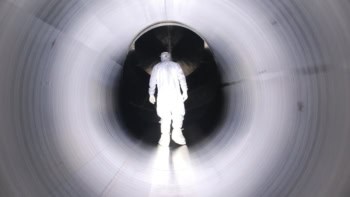
Scientists in China have released details for a huge particle collider that will produce over a million Higgs bosons in a seven-year period. The conceptual design report for the China Electron Positron Collider (CEPC) calls for a 100 km underground tunnel that would smash together electrons and positrons at energies of 240 GeV. The CEPC would be a successor to the Beijing Electron Positron Collider at the Institute of High Energy Physics (IHEP) in Beijing, which is expected to shut in 2020.
The CEPC, which was first proposed in 2012, is a “Higgs factory” – a facility to measure the precise properties of the Higgs boson, which was discovered at CERN in 2012 by scientists working on the Large Hadron Collider (LHC). An electron-positron machine can make much cleaner measurements than a proton collider like the LHC as its collisions do not produce as much debris. The CEPC will therefore allow the Higgs boson to be studied in unprecedented detail.
A preliminary conceptual design report for the CEPC was originally published in March 2015. That was followed by a progress report in April 2017, but the new 510-page conceptual design report, released this week on the arXiv preprint server, outlines the technical details of the accelerator. A second volume, featuring details of the CEPC detectors, is due to be released soon.
Particle factory
Estimated to cost around $6bn, the “heart” of the CEPC is a double-ring collider in which electron and positron beams will circulate in opposite directions in separate beam pipes. They will then collide at two “interaction points”, which will each contain a particle detector. The report reveals the CEPC will seek to generate over a million Higgs bosons over a seven-year period. The design also calls for the CEPC to operate at 91 GeV for two years to generate a trillion Z bosons as well as run at 160 GeV for a year to produce around 15 million pairs of W+ and W- particles.
We need to know what kind of support from the local government we will receive in terms of, for example, laboratories, living conditions, roads and power supply
Yifang Wang
Scientists will now build prototypes of key components of the accelerator and plan the manufacturing process required to construct the CEPC. If given the go-ahead by the government, construction of the CEPC could begin in 2022 and be complete by 2030. Following a decade of studying the Higgs, Z and W bosons, it is hoped that developments in magnet technology will be sufficient to begin construction of a proton-proton collider inside the existing tunnel in the early 2040s. This would operate in the range of 70-100 TeV and search for particles beyond the Standard Model of particle physics. Building the next collider
The location of the CEPC has not yet been decided with six locations currently satisfying the “technical requirements”. However, it is thought that the leading site is 300 km east of Beijing at the port city of Qinhuangdao. Speaking to Physics World earlier this year, IHEP director Yifang Wang says that a more detailed investigation of the geological conditions at some of the possible sites is needed before a decision can be made. “We need to know what kind of support from the local government we will receive in terms of, for example, laboratories, living conditions, roads and power supply,” he says.
Analysis: China could win the Higgs factory race
The race is on to build a Higgs factory – a successor to CERN’s Large Hadron Collider. For years it was thought that the International Linear Collider (ILC) was in pole position. The ILC’s five-volume technical design report was published in June 2013, calling for a 30 km-long linear collider that would smash electrons with positrons at around 500 GeV. The Japanese physics community quickly got behind the project expressing their desire to host the machine with a site in the Tōhoku region, about 400 km north of Tokyo, chosen as a potential location.
However, the Japanese government has dragged its feet over deciding to support the project and last year — to make the ILC more palatable — physicists came up with a revised plan, reducing the ILC’s energy to 250 GeV and shortening the length of the tunnel to around 20 km. While physicists hope that the Japanese government will now get behind the facility by the end of the year, there are many other projects vying for funding, no less a major new neutrino facility in Kamioka. It is likely that a decision about the ILC will be kicked further down the road.
There is another design for a linear collider to study the Higgs. The Compact Linear Collider would smash together electron with positron at energies up to 3 TeV, but despite a three-volume conceptual design report being released in 2012, it remains behind the ILC in terms of technical development. That now leaves the door open to China and momentum seems to be on their side. Speaking to Physics World earlier this year, Yifang Wang, head of China’s Institute of High Energy Physics, noted that there was “enormous interest” for the CEPC from funding agencies in the country.
Given the amount of cash that the Chinese government is ploughing into science as well as the technical ability of Chinese scientists and engineers to build world-class facilities, it would be hard to bet against the CEPC being first.



